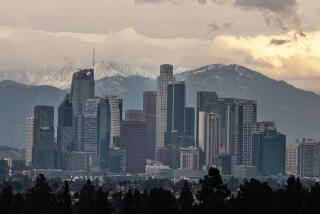Region’s S&Ls; suffer, survive
- Share via
Investors are increasingly throwing in the towel on Southern California-based savings-and-loan mortgage lenders IndyMac Bancorp, FirstFed Financial Corp. and Downey Financial Corp.
Defaults keep climbing on the nontraditional mortgages made by the companies, and bond buyers still shun securities backed by such loans. The lenders are awash in red ink, and their stocks are down by about half or more since the beginning of the year.
The companies -- which operate IndyMac Bank, First Federal Bank of California and Downey Savings & Loan -- have managed to survive long after nonbank sub-prime lenders such as Ameriquest Mortgage Co. of Orange and New Century Financial Corp. of Irvine melted down more than a year ago.
That’s partly because IndyMac, FirstFed and Downey didn’t specialize in sub-prime loans, so they didn’t lend to the category of borrowers considered most likely to default. In addition, as outside funding for mortgages dried up, the thrifts retained access to money from another source: their depositors. And because the S&Ls;’ deposits are federally insured, regulators require the thrifts to maintain extra capital and reserves against losses -- cushions that have served the firms well during the mortgage crisis.
But the losses keep coming.
On Monday, Pasadena-based IndyMac reported a loss of $184.2 million, or $2.27 a share, compared with a profit of $52.4 million, or 70 cents a share, a year earlier. To conserve cash, the company suspended dividend and interest payments on some preferred securities.
IndyMac shares slid 37 cents to $3.06, a record low. The stock is down 49% this year.
Shares of Los Angeles-based FirstFed, which recently moved its headquarters from Santa Monica, and Newport Beach-based Downey are down even more sharply this year -- 59% and 66% respectively.
By contrast, financial stocks in the Standard & Poor’s 500 index have slid only 10% on average year to date, and the BKX index of 24 major bank stocks is down about 7%.
Analysts said the deep declines for IndyMac, FirstFed and Downey reflect not just concern over losses but also fears that regulators will force the thrifts to add capital by bringing in new investors, which could devalue the stakes of current shareholders.
Many of the biggest Wall Street banks, whacked by sub-prime-related losses, already have been forced to raise billions in new capital, as did Seattle-based Washington Mutual Inc., the country’s largest savings and loan. And No. 1 home lender Countrywide Financial Corp. of Calabasas agreed in January to be acquired by Bank of America Corp. after running up $1.6 billion in losses during the second half of 2007.
IndyMac’s quarterly report shows its bank unit is at risk of falling from “well capitalized” to merely “adequately capitalized” as defined by its federal regulator, the Office of Thrift Supervision.
After an $88-million contribution from the parent company, IndyMac Bank’s core capital ratio was 5.74% and its risk-based capital ratio was 10.26%, compared with the benchmarks of 5% and 10%, respectively, for well-capitalized thrifts.
During a conference call with analysts, Chief Executive Michael Perry said IndyMac hoped to rebuild its core capital to 7% and risk-based capital to 11% by year-end.
To help it to do so, Perry said, IndyMac might sell its “reverse mortgage” business, Financial Freedom. Reverse mortgages allow older homeowners to convert some of their home equity into a stream of regular monthly payments while staying in their homes.
Selling the unit would be a sign of stress, said Keefe, Bruyette & Woods analyst Frederick Cannon, who called Financial Freedom one of the bank’s few operations that continued to appear strong.
Although Perry declined to predict when IndyMac would again turn a profit, he portrayed the thrift as on the upswing. He noted that unlike other banks, whose losses have widened of late, IndyMac’s has narrowed from the third and fourth quarters of 2007.
Cannon, who rates IndyMac shares “underperform,” expressed skepticism, citing previous optimistic predictions by Perry, some of which have not come to pass.
“Mike said today that they’ve turned the corner,” Cannon said. “But he’s said that so often that by now they’ve gone around the block at least once.”
Although the thrifts weren’t primarily sub-prime lenders during the mortgage boom, many of their customers fell into the “alt-A” category -- a notch below the lowest-risk, or prime, borrowers -- because they didn’t fully document their incomes or had other issues.
The thrifts also were major specialists in so-called pay-option adjustable-rate loans, which gave borrowers the option of paying so little that the loan balance rose.
Defaults on such “option ARM” loans started to skyrocket last year. That was bad news for Downey, which had more option ARMs on its books than any thrift except the far larger World Savings (now part of Wachovia Corp.), Washington Mutual and Countrywide, said Guy Cecala, editor of Inside Mortgage Finance, a trade publication.
Downey lost $247.7 million, or $8.89 a share, in the first quarter, compared with a profit of $42.9 million, or $1.54 a share, in the first quarter of 2007. It said it would slash dividend payments to shareholders and reported that its core capital ratio was 8.5% and its risk-based capital was 15%. Downey executives couldn’t be reached for comment Monday.
Unlike IndyMac, which sold nearly all its loans, and Downey, which sold some of them, FirstFed kept nearly all its loans on its books, giving it perhaps the best business model for a mortgage lender in the current environment, in which many home loans are hard to sell to investors, Cannon said.
Although critics question whether quirks in accounting rules have allowed FirstFed to exaggerate its strengths, its stated capital ratios are about twice the well capitalized benchmarks -- 10.23% for core capital and 19.63% for risk-based capital.
In the first quarter, FirstFed lost $69.8 million, or $5.11 a share, compared with net income of $32.4 million, or $1.92 a share, a year earlier, after setting aside $150.3 million on its books for loan losses. A year earlier, in the first quarter of 2007, its provision for loan losses was $3.8 million.
FirstFed Chief Executive Babette Heimbuch said the company’s goal was avoiding the need to raise capital “while at the same time adding good loans to replace the ones paying off or foreclosing.”
“Fortunately,” she said, “so many folks are out of the market,” reducing competition and letting FirstFed do well with the more-cautious home loans it now makes.
--
More to Read
Inside the business of entertainment
The Wide Shot brings you news, analysis and insights on everything from streaming wars to production — and what it all means for the future.
You may occasionally receive promotional content from the Los Angeles Times.











